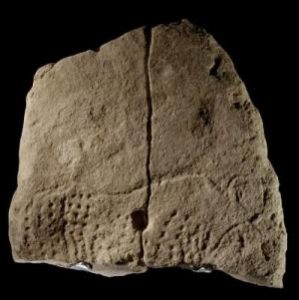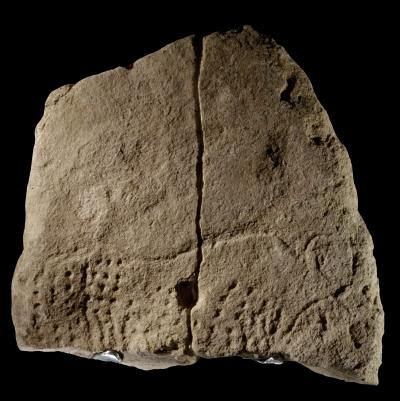
NEW YORK UNIVERSITY—An international team of anthropologists has uncovered a 38,000-year-old engraved image in a southwestern French rockshelter—a finding that marks some of the earliest known graphic imagery found in Western Eurasia and offers insights into the nature of modern humans during this period.
“The discovery sheds new light on regional patterning of art and ornamentation across Europe at a time when the first modern humans to enter Europe dispersed westward and northward across the continent,” explains NYU anthropologist Randall White, who led the excavation in France’s Vézère Valley.
The findings, which appear in the journal Quaternary International, center on the early modern humans’ Aurignacian culture, which existed from approximately 43,000 to 33,000 years ago.
Abri Blanchard, the French site of the recently uncovered engraving, a slab bearing a complex image of an aurochs, or wild cow, surrounded by rows of dots, was previously excavated in the early 20th century. White and his team members began their methodical exploration of remaining deposits at the site in 2011, with the discovery occurring in 2012.
__________________________________
An international team of anthropologists has uncovered a 38,000-year-old engraved image, above, in a southwestern French rockshelter—a finding that marks some of the earliest known graphic imagery found in Western Eurasia and offers insights into the nature of modern humans during this period. The limestone slab engraved with the image of an aurochs, or extinct wild cow, was discovered at Abri Blanchard in 2012. Credit: Musée national de Préhistoire collections – photo MNP – Ph. Jugie
______________________________________________
White contends that Aurignacian art offers a window into the lives and minds of its makers—and into the societies they created.
“Following their arrival from Africa, groups of modern humans settled into western and Central Europe, showing a broad commonality in graphic expression against which more regionalized characteristics stand out,” he explains. “This pattern fits well with social geography models that see art and personal ornamentation as markers of social identity at regional, group, and individual levels.”
Abri Blanchard and its sister site, Abri Castanet, previously excavated by White’s team, have long been recognized as being among the oldest sites in Eurasia bearing artifacts of human symbolism. Over time, hundreds of personal ornaments have been discovered, including pierced animal teeth, pierced shells, ivory and soapstone beads, engravings, and paintings on limestone slabs.
Article Source: New York University
______________________________________________
Subscribe to Popular Archaeology Premium. Available on all laptops and mobile devices, and still the industry’s best value at only $9.00 annually.
___________________________________________
Travel and learn with Far Horizons.
____________________________________________
This richly illustrated issue includes the following stories: Recent findings shedding new light on the whereabouts of the remains of Philip of Macedon, father of Alexander the Great; how an archaeologist-sculptor is bringing bones of the dead back to life; archaeologists uncovering town life at the dawn of civilization; an exclusive interview with internationally acclaimed archaeologist James M. Adovasio about what makes the Meadowcroft Rockshelter prominent in the ongoing search for the first Americans; what archaeologists are finding at the site of the ancient city of Gath, the home town of the biblical Philistine giant, Goliath; and how scientists are redrawing the picture of human evolution in Europe. Find it on Amazon.com.








